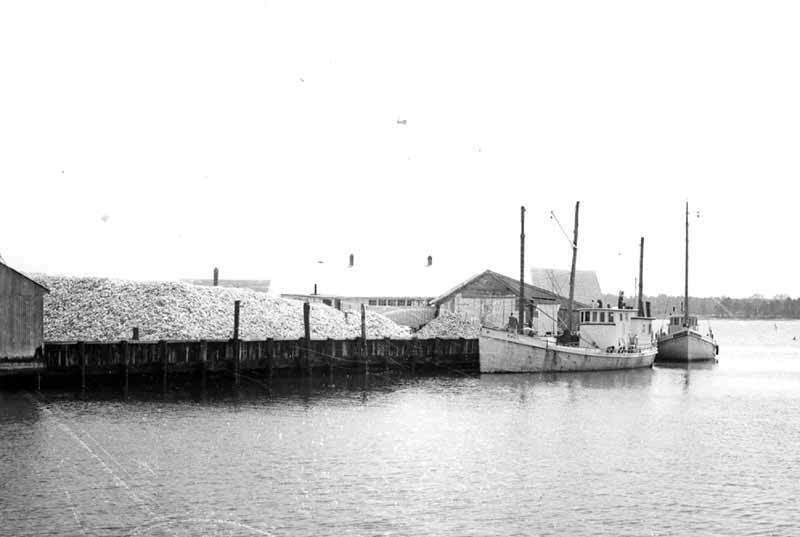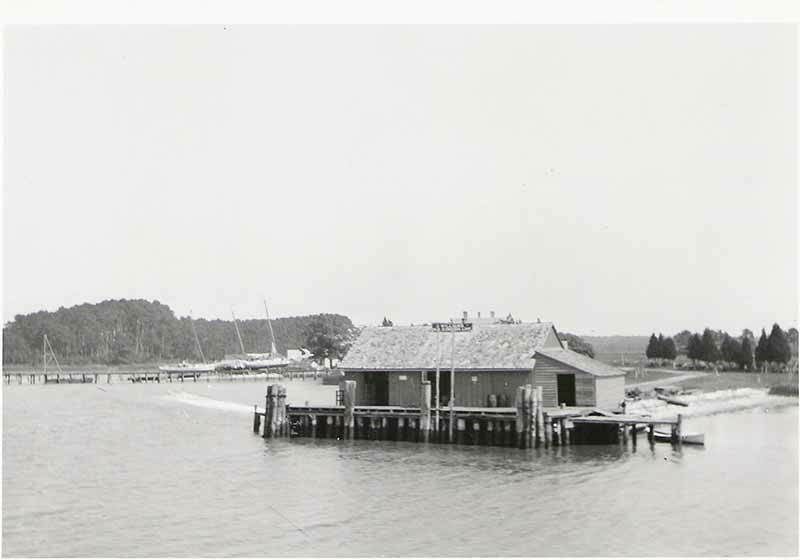History of the Wharf
Prior to the history of this land defined by European and American residents, it was occupied by the Kiskiak Indians, one of the 32 member tribes of the Powhatan Confederacy. Evidence of tribal life actually goes back to 6000 B.C., but we’ll start with the 1600s and tobacco. Indian tribes were driven away from this area by the early 1600s for use by English settlers who created plantations and fields of profitable tobacco. Williams Wharf played a big part in this as a port of call and was chosen as the location for an official tobacco inspection warehouse.
By the late 1700’s, Samuel Williams, the man who would give this site its name, purchased hundreds of acres on the East River, including an old tobacco warehouse and an apple orchard capable of producing 3,000 gallons of cider a year.
This was an area of tremendous shipbuilding activity as well, which served to increase the use of the Wharf. In 1802, a customs house was established, and a post office followed. In 1862, Union troops disembarked at the Wharf heading to New Point and Winter Harbor to destroy any vessels that could be used as blockade runners.
In 1869, the B. Williams Store, a landmark to this day, was built to serve the growing businesses and activities related to shipbuilding and, by the late1800’s, steamboat traffic. An interesting side note, in 1904, the store served as a location for church services for Kingston Parish, while a new church rose from the ashes of one that had burned down.
The floating theater boat the James Adams was a great success for a number of years and docked at Williams Wharf. It is reported that Edna Ferber wrote the Rogers and Hammerstein hit “Showboat” while living on the James Adams. The heyday of the steamboat era continued through the 1930s but was effectively ended by the Storm of 1933, which caused extensive destruction all along the coast. The commercial value of steamboats had been fading anyway, because of the use of smaller packet boats, and a growing trucking industry.
After steamboats, oysters and seafood became king at the Wharf, with the H.K. Billups and Sons shucking plant. Mountains of oyster shells produced the oysters for the famous yellow cans that were known for hundreds, if not thousands, of miles away. This continued through the 1950’s and early 1960s, but the seafood industry here was in decline, partly because of market forces and impact of the frozen fish industry, but partly because of oyster diseases and overfishing.
The next chapter saw the use of Williams Wharf as an oil depot, with companies associated with R.E. Armistead, Gulf and Trible Oil companies. This chapter ended in the early 1990s, with the closing of the businesses and foreclosure on the property. Following the closing of the oil business, and a bankruptcy hearing, the property went to foreclosure with a judge at the federal courthouse in Norfolk in 1994. The top bid was from a company that wanted to turn Williams Wharf into a deep-water location for a gravel distribution and shipping center.
As you might imagine, this kind of use may have had a significant negative impact on the waterfront and the surrounding areas, as well as the road, since heavy traffic and trucking would be involved. Fortunately for the neighborhood and future Mathews’ generations, two representatives from a small, newly created non-profit in Mathews County showed up with a different idea.
After it seemed there was no chance for them to prevail, their offer was accepted, and Williams Wharf became the home of the Mathews Land Conservancy and the Mathews High School Crew program. Community support grew for the MLC mission of providing public access to the Chesapeake Bay, a place for education and rowing activities, and a unique setting to preserve and promote natural resources and history for future generations.
Because of the significant generosity of Jeff and Rosalyn White and William F. and Catherine K. Owens, as well as major state and federal grants, work began to restore the land, preserve the history and build the public places for learning and recreation.
Before the first two phases could begin, local, state and federal permits had to be applied for and dozens of public hearings were conducted for public input and design revisions. There were legal and environmental requirements that had to be met, and detailed plans had to be produced to win approval at all levels. Extensive and expensive environmental and engineering standards were achieved. After permit approval, funds were raised and used for building a new shoreline, installing bulkheads, constructing a shoreline walkway, activity building, riverfront pavilion, floating dock, and fishing pier. The results have been experienced by thousands of visitors and residents.
The floating dock is used for small sailboats, canoes, kayaks and rowing. The fishing pier is also a spot for historic vessels to be seen and enjoyed, including the historic replica ship, Godspeed, of Jamestown, and both the Alliance and Serenity schooners based in Yorktown. And the Riverfront Pavilion provides the perfect central space for dozens of community and private events throughout the year, including the Party at the Wharf Series, Mathews Seafood Festival, MRA Crew Regattas, Tour de Chesapeake Cycling Event, Mathews Outdoor Club Micro-Triathlons and Open Water Swims, Mathews Rotary Oyster Roast and many more.
And now, Phase III of the plan is unfolding and a new history is being written. The framework for the Owens Maritime Education and Rowing Center is completed and, when finished, half of the building will provide the space for maritime education and community learning events and activities, while the other half will be the center for rowing activities and programs to support the Mathews High School crew team, the Mobjack Rowing Association and other non-motorized water craft.
We will be able to partner with schools, universities, historic preservation organizations and marine science-related agencies to bring special events, students and local organizations together in a unique setting that is respectful of our location and inspiring to young people. We will be able to host historic vessel visits, workboat demonstrations, sailing regattas and other water-based attractions. Individuals, organizations, businesses, and our local economy will all benefit from this new chapter in the history of Williams Wharf.















